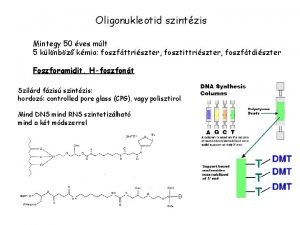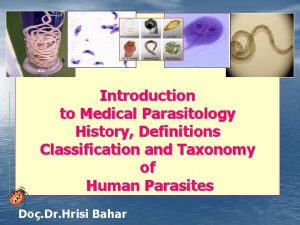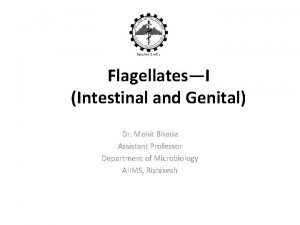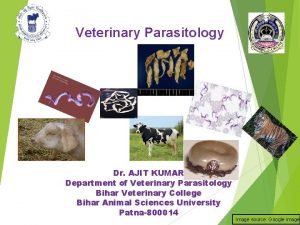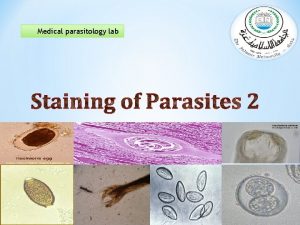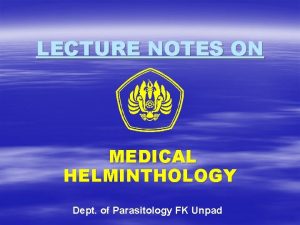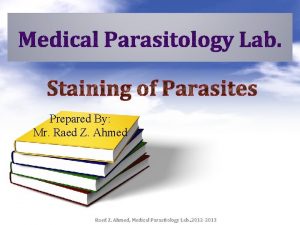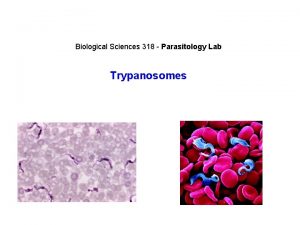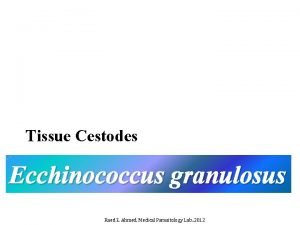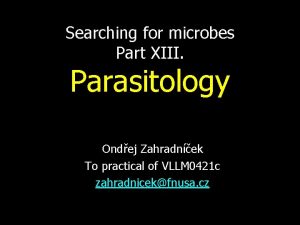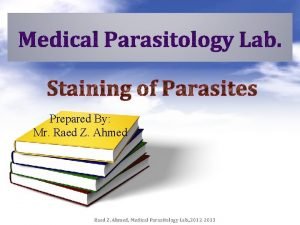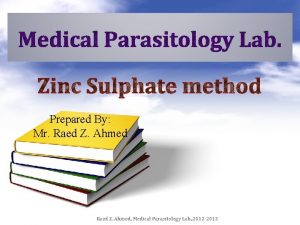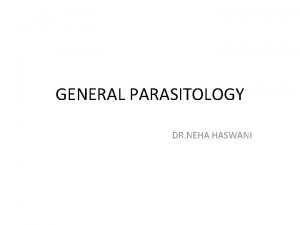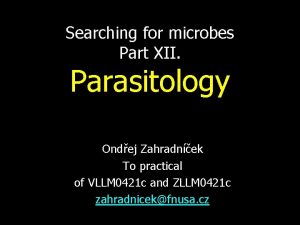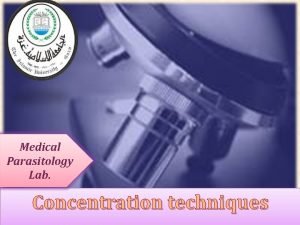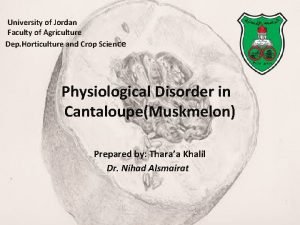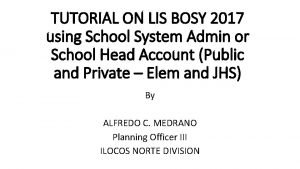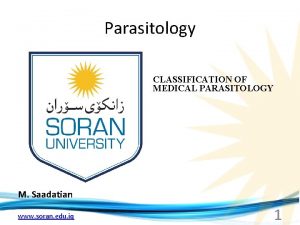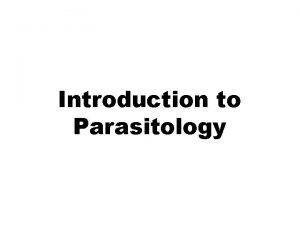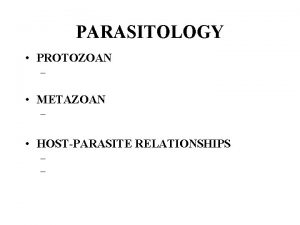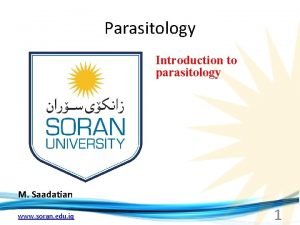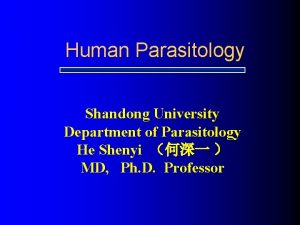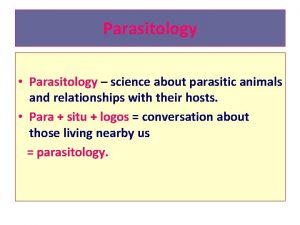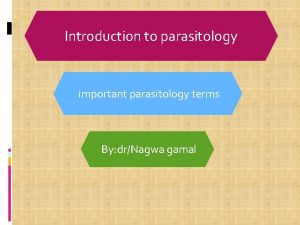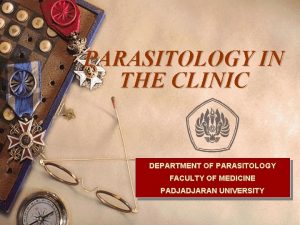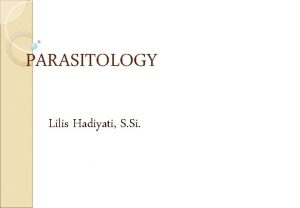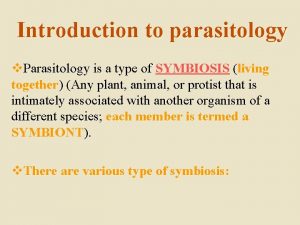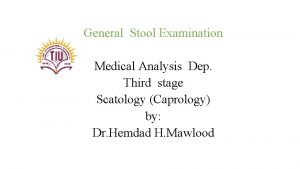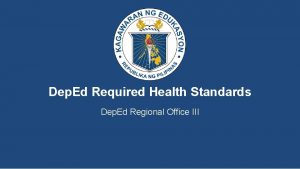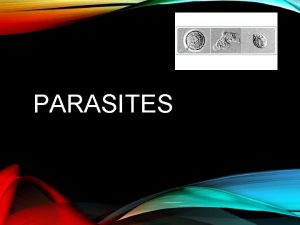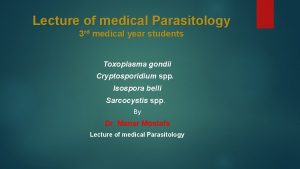Medical Parasitology MLT Dep Second stage Medical Analysis








































- Slides: 40

Medical Parasitology MLT Dep. Second stage Medical Analysis Dep. Third stage by: Dr. Hemdad Hawez Mawlood Ph. D Medical Parasitology 1

• Parasitic diseases continue to be a major public health problem all over the world with associated high degree of morbidity and mortality • WHO statistics put parasites as a leading cause of death after HIV/AIDs and tuberculosis • Out of 60 million deaths in world, more than 25% are accounted to parasites. • Parasites affect over half the world’s population and are a major cause of mortality in the developing country. 2

3

• Five parasitic infections – Malaria – Trypanosomiasis – Leishmaniasis, – Schistosomiasis Presenting the greatest challenges in the developing country – Filariasis 4

• Many infections once thought to be harmless, are now known to be life-threatening in immunocompromised individuals and those suffering from acquired immunodeficiency syndrome (AIDS). These include: – Toxoplasma gondii – Cryptosporidium parvum – Isospora belli – Microsporidia 5

• Parasite also have capacity to develop drug resistance • Vectors transmitting certain parasitic infections have developed insecticide resistance 6

• Parasitology is the area of biology concerned with the phenomenon of dependence of one living organism on another. • PARASITE A parasite is an organism that is entirely dependent on another organism, referred to as its host, for all or part of its life cycle and metabolic requirements. It is of two types: • Microparasite • Macroparasite 7

q. Microparasite It is small, unicellular and multiplies within its vertebrate host, often inside cells. protozoa are microparasites. q. Macroparasite It is large, multicellular This category includes helminthes. Ex. Fasiola hepatica 8

q On the basis of their location, parasites may also be divided into two types: 1. Ectoparasites Organisms which live on the surface of the skin or temporarily invade the superficial tissues of the host (e. g. Louse (plural is lice) such as human head lice (pediculosis capitis ). ). The infection by these parasites is known an infestation. 2. Endoparasites Organisms that live within the body of the host. All protozoan and helminthic parasites of human are endoparasites. The invasion by endoparasites is known as infection 9

On the basis of host, parasites are subdivided into the following types: Obligate parasites: Organisms that cannot exist without a host (e g. Toxoplasma gondii) Facultative parasites: Organisms that under favorable circumstances may live either a parasitic or free-living existence (e. g. Naegleria fowleri, Acanthamoeba spp. 10

Acanthamoeba spp Naegleria fowleri

Accidental or incidental parasites: Organisms that attack an unusual host (e. g. Echinococcus granulosus in man). Aberrant parasites: Organisms that attack a host where they cannot live or develop further (e. g. Toxocara canis in man). 12

Free-living: The term free-living describes the nonparasitic stages of existence which are lived independently of a host. e. g. hookworms such as: Ancylostoma duodenale and Necator americanus have active free-living stages in the soil.

Ø Commensal Parasites are parasites which do not harm their hosts Entamoeba coli. Ø Pathogenic Parasites are those which cause diseases to their hosts. Entamoeba histoloytica Ø Opportunistic Pathogens are commensal or free living organisms which become pathogenic under special circumstances. Like Toxoplasma gondii

Ø Temporary parasites such as: leeches (Hirudo medicinalis) and bed bugs (Cimex lectularius) visit their host only for a short period of time.

16

HOST is defined as an organism which harbors the parasite and provides the nourishment and shelter to the latter. Type of Host Definitive host This is the host in which sexual reproduction of the parasite takes place or in which the most highly developed form of a parasite. The definitive host is the mammalian host. Example Felines are final host for Toxoplasma gondii 17

intermediate host The host which alternates with the definitive host and in which the larval or asexual stages of a parasite are found. Some parasites require two intermediate hosts for completion of their life cycle, the first one is called first IH and the 2 nd called 2 nd IH, which usually harbor the infective stages which infect the DH. example the first IH for Clonorchis sinensis is snail while second IH is a freshwater fish. 18

q Paratenic host A host in which larval stage of a parasite survives but does not develop further. It is often not a necessary part of the life cycle. Such as fleas Reservoir host A host which harbors the parasite and serves as an important source of infection to other susceptible hosts. Epidemiologically, reservoir host are important in the control of parasitic diseases. The women genital tract (Bartholin glands ) is the only reservoir for the Trichomonas vaginalis

Zoonosis • This term is used to describe an animal infection that is naturally transmissible to humans either directly or indirectly via a vector. Examples of parasitic diseases that are zoonotic include: - Leishmaniasis, - South American trypanosomiasis, - Rhodesien trypanosomiasis. - Japonicum schistosomiasis, - Trichinosis, fascioliasis, - Hydatid disease 20

21

Vector • A vector is an agent, usually an insect, that transmits an infection from one human host to another. • The term mechanical vector is used to describe a vector which assists in the transfer of parasitic forms between hosts but is not essential in the life cycle of the parasite e. g. a housefly that transfers amoebic cysts from infected food that is eaten by humans. • Biological Vector: Is the vector in which the parasite undergo development. 22

HOST-PARASTTE RELATIONSHIPS • Symbiosis An association in which both host and parasite are so dependent upon each other that one can not live without the help of the other. • Commensalism An association in which only parasite derives benefit without causing any injury to the host. • Parasitism is a relationship in which a parasite benefits and the host provides the benefit. The host gets nothing in return and always suffers from some injury. The degree of dependence of a parasite on its host varies 23

Crocodile Plover bird • a large predatory semiaquatic reptile with long jaws, long tail, short legs, and a horny textured skin. 24

SOURCES OF INFECTION Parasitic infections originate from following sources: 1. Contaminated soil and water; Soil polluted with human excreta acts as a source of infection with - Ascaris lumbricoides, - Trichuris trichiura, - Ancylostoma duodenale, - Necator americanus and - Strongyloides stercoralis Before acquiring infectivity for man, eggs of these parasites undergo certain development in the soil. These are known as soil transmitted helminthes 25

• Water polluted with human excreta which may contain viable cysts of – Entamoeba histolytica, – Giardia lamblia, – Balantidium coli, eggs of - Taenia solium, - Hymenolepis nana, and the infective cercarial stage of - Schistosoma haematobium, - S. mansoni - S. japonicurn. 26

2. Freshwater fishes constitute the source of Diphylobothrium latum and Clonorchis sinensis. 3. Crab and crayfishes are the sources of Paragonimus westermani. 4. Raw or undercooked pork is the source of Trichinella spiralis, T. solium, and Sarcocystis suihominis. 5. Raw or undercooked beef is the source of T. saginata, Toxoplasma gondii, and Sarcocystis hominis. 27

6. Watercress is the source of Fasciola hepatica. 7. Blood-sucking insects transmit Plasmodium spp. , Wuchereria bancrofti, Brugia malayi, Onchocerca volvulus, T. brucei, T. cruzi, Leishmania spp. and Babesia spp. 8. Housefly (mechanical carrier) is the source of E. histolytica. 9. Dog is the source of Echinococcus granulosus and Toxocara canis (visceral larva migrans). 28

10. Cat is the source of T. gondii, 11. Man is the source of E. histolytica, Enterobius vermicularis, and H. nana. 12. Autoinfection may occur with E. vermicularis and S. stercoralis, leading to hyperinfection, 29

PORTAL OF ENTRY INTO THE BODY 1. Mouth The commonest portal of entry of parasites is oral, through contaminated food, water, soiled fingers or fomites. – This mode of transmission is referred to as faecal-oral route. – e. g. • • • E. histolytica, G lamblia, E. vermicularis, T. trichiura, T. spiralis, T. solium, D. latum, F. hepatica, Fasciolopsis buski, B. coli. A. lumbricoides, T. saginata, C. sinensis P. westermani 30

2. Skin • Infection with A. duodenale, N. americanus and S. stercolaris is acquired when filariform larvae of these nematodes penetrate the unbroken skin of an individual walking over faecally contaminated soil. • Schistosomiasis caused by S. haematabium, S. mansoni and S. japonicum is acquired when the cercarial larvae, in water, penetrate the skin. • A large number of parasites e. g, Plasmodium spp. , W. bancrofti, B. malayi, O. volvulus, T. brucei, T. cruzi, Leishmania spp. and Babesia spp. are introduced percutaneoursly when blood-sucking arthropods puncture the skin to feed. 31

3. Sexual contact Trichomonas vaginalis is transmitted by sexual contact, E. histolytica and G. lamblia may also be transmitted by anal-oral sexual practices among male homosexual 4. Kissing E. gingivalis is transmitted from person-to-person by kissing or from contaminated drinking utensils. 5. Congenital Infection with T. gondii and Plasmodium spp. may be transmitted from mother to fetus transplacentally 32

6. Inhalation Airborne eggs of E. vermicularis may be inhaled into posterior pharynx leading to infection. 7. latrogenic infection - Malaria parasites transmitted by transfusion of blood from the donor with malaria containing asexual forms of erythrocytic schizogony This is known as trophozoite-induced malaria or transfusion malaria. - Malaria parasites may also be transmitted by the use of contaminated syringes and needles This may occur in drug addicts. 33

LIFE CYCLE OF HUMAN PARASITES • On the basis of their life cycles human parasites can he divided into three major groups: NO INTERMEDIATE HOST Protozoa Helminths Entamoeba histolytica G. lamblia Chilomastix mesnili T. vaginalis B. coli E. vermicularis T. trichiura Ascaris lumbricoides A. duodenale N. americanus H. nana 34

ONE INTERMEDIATE HOST PARASITE pig T. solium T. Spiralis Mosquito W. bancrofti B. malayi Cow Man T saginata Snail Schistosoma spp. E. granulosus Plasmodium spp. Copepod D. medinensis Flea H. nana Triatomine bug Fly: - Sandfly - Tsetse - Chrysops (deer fly) Simulium(black fly) T. cruzi Leishmania Trypanosoma spp. Loa loa O. volvulus 35

TWO INTERMEDIATE HOSTS PARASITE Snail, crustacean Paragonimus westermani Cyclops, fish Diphyllobothrium latum Snail, fish Clonorchis sinensis Snail, plant Fasciola spp. 36

1 -Simple life cycle Entamoeba histolytica life cycle

2 -Complicated life cycle eg. Trypanosoma, require transmitting vector

Heterophyidae life cycle, complicated with 2 intermediate hosts

LITERATURE 1. Arora, D. R. and B. Arora, 2007, Medical Parasitology, 2 nd ed. , CBS Publ. & Distributor, New Dehli 2. Markell, E. K. , M. Voge, and D. T. John, 1992, Medical Parasitology, 7 th ed. , WB Saunders Co. , Philadelphia 3. Peters, W. & H. M. Gilles, A Colour Atlas of Tropical Medicine & Parasitology, 3 rd. ed. , Wolfe Medical Publ. Ltd, Netherlands maria immaculata iwo, sf itb 40
 学乐moe
学乐moe Mlt 5
Mlt 5 Classification of medical parasitology
Classification of medical parasitology Parasitism
Parasitism Essentials of medical parasitology
Essentials of medical parasitology Father of veterinary parasitology
Father of veterinary parasitology Cryptosporidium parvum
Cryptosporidium parvum Wormhost chest worm locations
Wormhost chest worm locations Ancylostoma
Ancylostoma Hymenolepis nana
Hymenolepis nana Parasitology
Parasitology Taenia egg
Taenia egg Toxoplaxmosis
Toxoplaxmosis Miracidium
Miracidium Parasitology
Parasitology Raed eggs
Raed eggs General parasitology lecture notes
General parasitology lecture notes Emaplex
Emaplex Sedimentation technique for stool concentration
Sedimentation technique for stool concentration Criterio de pista compensada
Criterio de pista compensada Dep horticulture
Dep horticulture Depuser
Depuser Dep
Dep Dep cpu
Dep cpu Jini dep
Jini dep ıml32.dll indir
ıml32.dll indir Dep email
Dep email Dep environmental education grants
Dep environmental education grants Giô dép
Giô dép Eval dep taocloud
Eval dep taocloud Asterix cat062
Asterix cat062 Dep hkps
Dep hkps Lis dep
Lis dep Dep training modules
Dep training modules Nstoria
Nstoria Bypass dep
Bypass dep Dep clause
Dep clause 186 282 miles per second into meters per second
186 282 miles per second into meters per second Discontinuity of development
Discontinuity of development Latent phase
Latent phase Butterfly life cycle for grade 3
Butterfly life cycle for grade 3

